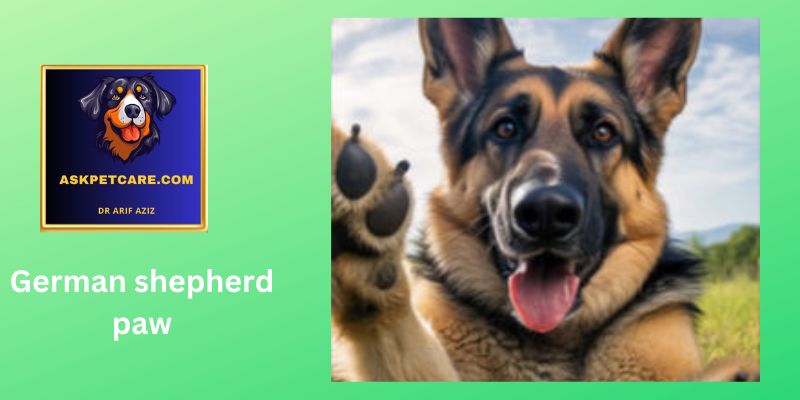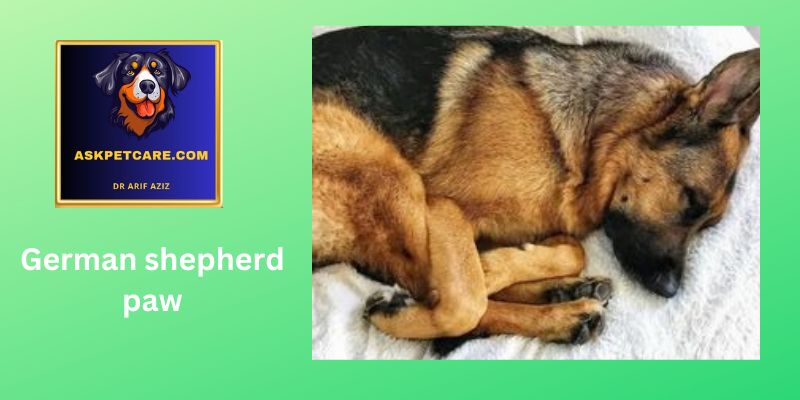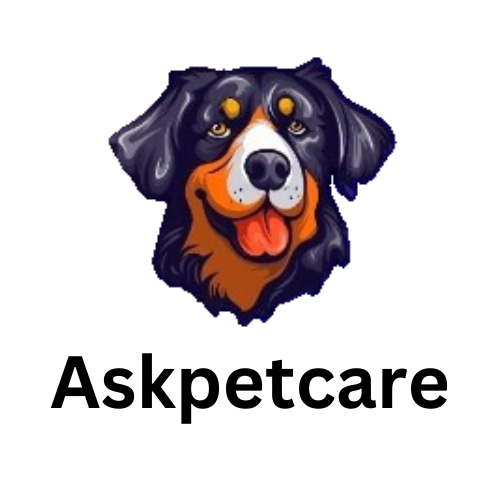Hello dog lovers I am Dr. Arif Aziz in this blog post I will thoroughly explain the German shepherd paw. I’ll tell you about German Shepherd paws – what they look like, how to take care of them, and what they can tell us about how our furry friends feel. Let’s explore together why a German Shepherd’s paw is such a big deal.
I’ve been taking care of pets especially dogs at my clinic for a long time, exactly 14 years! I’m here to share some valuable information with you that I’ve gathered from books during my study time written by experts in veterinary medicine (DVM) and MSC (Master of Science), as well as from my own experiences working with dogs. I’ve been running my Veterinary Clinic for the past 14 years.

German Shepherd paw is super important for them. It’s not just a part of their body, but it helps them do a lot of things and shows how strong they are. German Shepherds are popular dogs worldwide because they’re smart and loyal. Their paws play a big role in keeping them healthy and happy.
Anatomy of a German Shepherd Paw:
The structure of a German Shepherd’s paw consists of several key components essential for their mobility and well-being:
Pads:
German Shepherds have thick, cushioned pads on the underside of their paws. These pads provide protection against rough terrain, hot surfaces, and cold temperatures. They also aid in shock absorption while walking or running, contributing to your dog’s comfort and stability.
Nails:
German Shepherds typically have strong, curved nails that play a vital role in traction and grip during various activities. However, if left untrimmed, nails can become overgrown and lead to discomfort, difficulty walking, or even injury. Regular nail trimming is crucial to maintaining your dog’s paw health and preventing potential issues.
Interdigital Spaces:
Between the toes of a German Shepherd’s paw lie interdigital spaces, which are susceptible to debris, dirt, and moisture accumulation. Proper hygiene and grooming help prevent interdigital issues such as cysts, infections, or irritation.
Importance of Healthy Paw Anatomy:
Maintaining healthy paw anatomy is essential for your German Shepherd’s overall well-being and mobility:
Comfort and Mobility:
Healthy paws enable your dog to move comfortably and confidently, whether they’re walking, running, or engaging in physical activities. Any discomfort or pain in the paws can significantly impact your dog’s mobility and quality of life.
Protection from Injuries:
Whole paw pads and properly trimmed nails provide natural protection against injuries, abrasions, and infections. By ensuring your dog’s paw anatomy is in good condition, you help minimize the risk of common paw-related issues.
Paw Care Routine:
To promote and maintain healthy paw anatomy in your German Shepherd, incorporate the following routine into your care regimen:
Regular Inspection:
Take time to inspect your dog’s paws thoroughly for any signs of injury, cracks, swelling, or foreign objects lodged between the toes. Early detection allows prompt intervention and prevents minor issues from escalating into more significant problems.
Cleaning:
After outdoor activities, especially in muddy or snowy conditions, gently clean your German Shepherd’s paws with lukewarm water and a mild pet-safe cleanser. This helps remove dirt, debris, and potentially harmful substances, reducing the risk of infections and irritation.
Nail Trimming:
Trim your dog’s nails regularly using proper pet nail clippers to maintain an optimal length. Overgrown nails can cause discomfort, affect your dog’s gait, and even lead to joint problems over time. Aim to trim the nails just above the quick (the pink part of the nail) to avoid causing pain or bleeding.
Moisturizing:
Apply a pet-safe paw balm or moisturizer to your German Shepherd’s paw pads to keep them hydrated and supple. This helps prevent dryness, cracking, and discomfort, especially during dry or cold weather conditions.

By incorporating these paw care practices into your routine, you can ensure that your German Shepherd’s paws remain healthy, resilient, and ready for any adventure.
if you like to learn more click bellow.
how-to-cut-your-german-shepherds-nails.
lump-on-dog-paw-dr-understanding.
Most Common Paw Issues:
German Shepherds, like other breeds, may encounter various paw-related problems that can affect their comfort and mobility:
- Paw Pad Injuries: German Shepherds are often active dogs that enjoy outdoor activities. Paw pad injuries can occur from walking on rough terrain, abrasive surfaces, or hot pavement during summer months. Signs of paw pad injuries include limping, licking or chewing at the paws, visible cuts or abrasions, and reluctance to walk.
- Interdigital Cysts or Infections: Interdigital spaces between a dog’s toes are prone to cysts or infections caused by bacteria or fungi. Symptoms may include swelling between the toes, redness, discharge, licking or chewing at the affected area, and lameness or discomfort while walking.
- Cracked or Broken Nails: Trauma or overgrowth can lead to cracked or broken nails in German Shepherds. This can occur from excessive scratching, catching the nail on objects, or improper nail trimming. Signs of cracked or broken nails include limping, reluctance to put weight on the affected paw, bleeding, and visible damage to the nail.
Very important Preventive Measures:
To minimize the risk of issues in your German Shepherd paw, consider implementing the following preventive measures:
- Provide Appropriate Footwear: Invest in protective footwear for your dog, especially during extreme weather conditions such as hot pavement or icy surfaces. Dog boots can shield your German Shepherd’s paws from injuries and temperature extremes.
- Maintain a Healthy Lifestyle: Ensure your German Shepherd maintains a balanced diet and receives regular exercise to promote overall paw health. Regular physical activity helps strengthen paw muscles and maintains joint flexibility, reducing the risk of injury.
- Safe Living Environment: Keep your dog’s living environment clean and free from sharp objects, chemicals, or potential hazards that could harm their paws. Regularly inspect indoor and outdoor areas for any potential dangers.
- Schedule Veterinary Check-Ups: Regular veterinary check-ups are essential for monitoring your German Shepherd’s paw health and addressing any emerging issues promptly. Your veterinarian can provide preventive care recommendations tailored to your dog’s needs and detect early signs of paw problems.
When Seeking Veterinary Care:
If you notice any signs of discomfort, swelling, persistent limping, or other abnormalities in your German Shepherd’s paws, it’s crucial to seek veterinary care promptly. Early intervention can prevent minor paw issues from worsening and ensure your dog receives appropriate treatment and relief from discomfort. Your veterinarian can conduct a thorough examination, diagnose the underlying cause, and recommend the most suitable treatment plan for your German Shepherd’s paw condition.

What should German Shepherd paw look like?
German Shepherd paws should exhibit characteristics of health and functionality. Here’s what you should look for:
- Paw Pads: The paw pads of a German Shepherd should be smooth, supple, and free from cuts, cracks, or excessive wear. Healthy paw pads provide cushioning and protection against rough surfaces and extreme temperatures.
- Nails: German Shepherds typically have strong, well-maintained nails that are proportional to the size of their paws. Nails should be trimmed to an appropriate length, neither too long nor too short, to prevent discomfort or issues with gait.
- Interdigital Spaces: The spaces between the toes should be clean and free from debris, irritation, or signs of infection. Any redness, swelling, discharge, or odor in the interdigital spaces may indicate a potential issue that requires attention.
- Size and Symmetry: German Shepherd paws should be proportionate to the size and build of the dog. They should appear symmetrical and balanced, with no obvious signs of deformity or abnormalities.
Overall, a healthy German Shepherd paw should facilitate comfortable movement, provide adequate traction, and exhibit signs of proper maintenance and care.
How big are German Shepherd paws?
German Shepherd paws vary in size depending on the individual dog’s age, genetics, and overall build. Generally, German Shepherds have large, well-padded paws that are proportionate to their body size and weight.
As puppies, German Shepherds may have relatively large paws compared to the rest of their body, indicating potential growth and development. As they mature, their paw size will typically align with their adult proportions.
Adult German Shepherds typically have paws that are large enough to provide stability and support during various activities, including running, jumping, and navigating different types of terrain. The size of their paws contributes to their agility, balance, and overall athleticism.
What does it mean when a German Shepherd puts its paw on you?
When a German Shepherd puts its paw on you, it can convey different meanings based on the context and the dog’s individual behavior:
- Affection and Attention-Seeking: In many cases, a German Shepherd may put its paw on you as a sign of affection or a gesture of seeking attention. Your dog may be expressing a desire for physical contact, closeness, or interaction with you.
- Seeking Comfort or Reassurance: If your German Shepherd is feeling anxious, uncertain, or seeking reassurance, they may place their paw on you as a way of seeking comfort and security. It can be a comforting gesture for the dog to feel your presence and support.
- Training or Behavior Conditioning: Some German Shepherds may have been trained to offer their paw as a learned behavior in response to specific cues or commands. This behavior can be reinforced through positive reinforcement training methods.
- Asserting Dominance: In rare cases, a German Shepherd may place its paw on you as a display of dominance or territorial behavior. However, this behavior is less common and often accompanied by other assertive gestures or body language.
Overall, interpreting why a German Shepherd puts its paw on you requires considering the context, your dog’s temperament, and their communication cues. It’s essential to observe your dog’s body language and behavior patterns to understand their intentions and respond accordingly with positive reinforcement and appropriate training techniques.

Why do German Shepherds tuck their paws? explain
German Shepherds, like many other dog breeds, may tuck their paws for various reasons, which can indicate different emotions or behaviors:
- Relaxation: Tucking their paws under their body while lying down can be a sign of relaxation and comfort for German Shepherds. Just like humans might curl up to get cozy, dogs may tuck their paws to feel secure and at ease.
- Temperature Regulation: Dogs regulate their body temperature through their paws. When they tuck their paws close to their bodies, it can help conserve heat in colder environments or cool down in warmer conditions. So, if your German Shepherd is tucking their paws, they might be trying to regulate their body temperature.
- Anxiety or Stress: In some cases, tucking their paws may indicate anxiety or stress in German Shepherds. Dogs may tuck their paws if they’re feeling nervous, uncomfortable, or fearful in a particular situation. It could be their way of trying to protect themselves or seek comfort.
- Pain or Discomfort: If your German Shepherd is experiencing pain or discomfort in their paws or elsewhere in their body, they may tuck their paws as a response. Tucking their paws could help alleviate some of the discomfort they’re feeling by reducing pressure or tension on the affected area.
- Submissive Behavior: Tucking their paws can also be a sign of submission in dogs. If your German Shepherd is tucking their paws while interacting with other dogs or people, it could indicate that they’re trying to show deference or avoid conflict.
Overall, observing your German Shepherd’s body language and considering the context of their behavior can help you understand why they might be tucking their paws. If you notice any concerning or persistent changes in your dog’s behavior, it’s always a good idea to consult with a veterinarian to rule out any underlying health issues or discomfort. I hope you will completely understand about the German shepherd paw. If you have any queries, contact me.
Here are some reference books that are considered authoritative on the topic of dog care, including nail care:
- “The Complete Dog Owner’s Manual” by Dr. Bruce Fogle
- “The Ultimate Guide to Dog Care: Everything You Need to Know to Keep Your Dog Happy and Healthy” by Amy Marder and Andrew Luescher

3 thoughts on “German shepherd paw. Dr.practical tips and tricks”